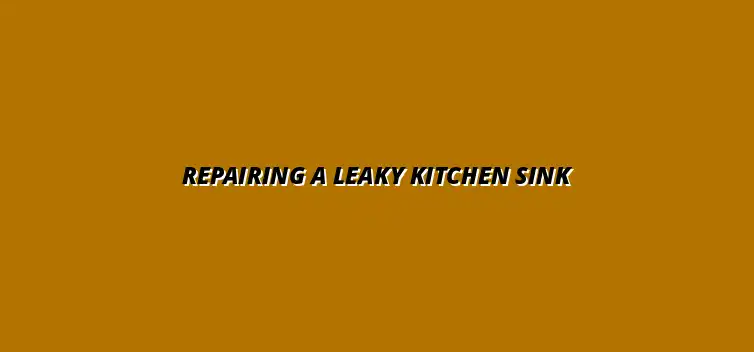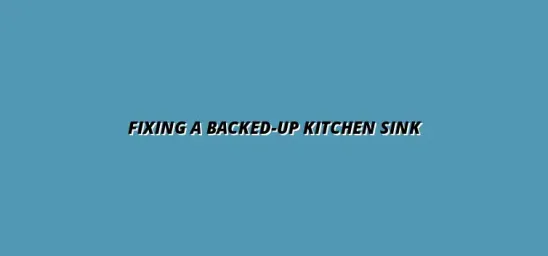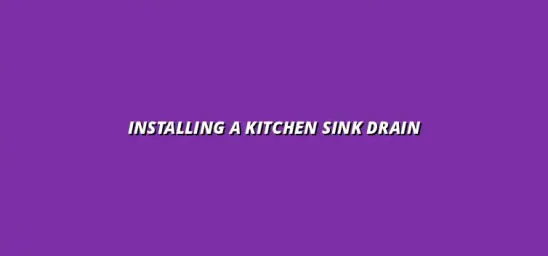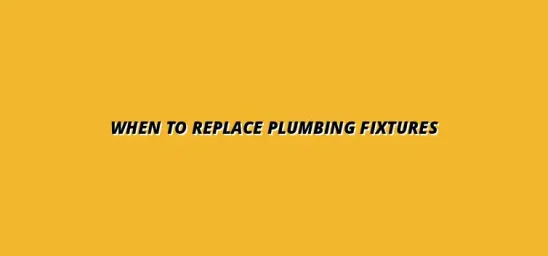
Repairing a Leaky Kitchen Sink
Understanding Kitchen Sink Pipe Leaks
Kitchen sink pipe leaks can be a real headache for homeowners. They can lead to water damage, mold growth, and even costly repairs if not addressed quickly. To tackle these issues effectively, it’s important to understand the common causes of leaks in kitchen sink pipes and how to identify them early.
Often, leaks can stem from several factors that might seem minor at first but can escalate into bigger problems. In this article, we will explore the common culprits behind these pesky leaks, helping you to not only spot them but also take action before they turn into major headaches!
Common Causes of Leaks in Kitchen Sink Pipes
Identifying the root cause of your kitchen sink pipe leak is crucial for a successful repair. Here are some of the most common reasons leaks occur:
- Worn Out Seals and Gaskets: Over time, seals and gaskets can degrade, causing water to seep out.
- Corrosion in Metal Pipes: Older metal pipes can corrode, leading to holes and leaks.
- Loose Connections and Fittings: Connections that are not tightened properly can lead to leaks at the joints.
- Clogs Leading to Pipe Damage: When pipes are clogged, pressure builds up, which can eventually cause them to burst. Regularly cleaning your drains to avoid clogs is crucial; here's a helpful guide on quick ways to unblock a sink.
Worn Out Seals and Gaskets
Seals and gaskets are essential in preventing leaks between pipe connections. Over time, these components can become brittle or cracked due to constant exposure to water and varying temperatures. When this happens, they can no longer provide an adequate seal, resulting in leaks.
Regularly checking and replacing worn seals and gaskets can save you from dealing with major leaks in the future. Just a few minutes of inspection can help you catch potential issues before they escalate!
Corrosion in Metal Pipes
If you have older metal pipes, corrosion might be your enemy. When metal pipes start to rust, they can develop weak spots and holes, which lead to leaks. This issue is more common in areas with hard water or those that have been exposed to moisture for extended periods.
Keeping an eye on the condition of your pipes and replacing them if necessary can help maintain a leak-free kitchen!
Loose Connections and Fittings
Sometimes, the simplest cause of a leak is just a loose connection or fitting. When these parts come apart, even slightly, water can escape and create a mess. It's a good idea to periodically check these connections and tighten them if needed.
Remember, a little maintenance goes a long way in preventing leaks. Don’t wait until it’s too late—take a few moments to inspect your sink's connections! For more comprehensive plumbing maintenance tips, check out this guide: Plumbing Maintenance Tips for Homeowners.
Clogs Leading to Pipe Damage
Clogs can create significant pressure in pipes, making them more susceptible to leaks. This pressure can cause joints to separate and pipes to rupture. It’s important to regularly clean your drains to avoid clogs. Learning how to prevent kitchen sink blockages easily can save you a lot of hassle.
- Use a strainer to catch food particles.
- Pour hot water down the drain weekly.
- Consider using baking soda and vinegar for a natural cleaning method.
By taking these steps, you can keep your pipes free from clogs and in good shape!
Identifying the Source of the Leak
Finding the source of a leak can feel like a detective mission! But with a little know-how, you can easily track it down. Start by looking for obvious signs of water damage, such as stains or puddles. From there, we can dive into some effective inspection techniques.
In the following sections, we’ll discuss various methods to help you pinpoint the exact spot of that pesky leak, so you can take action swiftly!
Step-by-Step Guide to Repairing a Leaking Kitchen Sink Pipe
When faced with a leaking kitchen sink pipe, it's important to tackle the repair process methodically. By following a clear step-by-step guide, you can effectively address the problem and minimize water damage to your kitchen. Remember, taking your time and ensuring each step is done correctly will lead to a successful repair!
Starting with the right approach not only helps you fix the leak but also gives you confidence in handling similar issues in the future. So, let's jump right into the steps you need to take to get that sink back in working order!
Turning Off Water Supply Safely
Before you begin any repair work, you must turn off the water supply to prevent further leakage. This is a crucial first step that will save you from dealing with a mess while you work. Make sure to locate the shut-off valves and turn them off firmly!
- Find the shut-off valves under the sink—these are usually connected to the hot and cold water lines.
- Turn the valves clockwise until they are tight to completely stop the flow of water.
- If you can't find local shut-off valves, you may need to turn off the main water supply to your home.
Once the water supply is off, it's wise to drain the pipes before starting repairs. This will help you avoid any unexpected water spillage while you work!
Locating the Shut-Off Valves
To repair your leaking pipes, you first need to locate the shut-off valves. These valves are typically found in a few common places:
- Underneath the sink, attached to the water supply lines.
- On the wall behind the sink.
- Alongside the base of the faucet.
Always check both the hot and cold water lines to ensure they are both shut off. This small step can prevent a lot of water from escaping while you work!
Draining the Pipes Before Starting Repairs
After turning off the water supply, it's crucial to drain the pipes. To do this, follow these steps:
- Open the faucet to allow any remaining water to flow out.
- Use a bucket to catch any excess water that might come out of the pipes.
- Check for any residual water by shaking the pipes gently.
With the pipes drained, you can now proceed with repairs without worrying about getting drenched!
Repairing or Replacing Pipe Components
Now that you've safely turned off the water and drained the pipes, it's time to address the actual repair. Depending on the cause of the leak, you may need to tighten connections, replace seals, or even swap out damaged pipes. Let's explore how to handle each of these tasks!
Don’t forget, it’s important to assess the condition of each component before deciding whether to repair or replace it. This will ensure you’re making the most cost-effective choice!
Tightening Loose Connections
If you’ve found that your leak is due to loose connections, you can easily resolve this with a few simple tools. Consider the following steps:
- Use a pipe wrench or pliers to gently tighten any loose fittings.
- Be careful not to overtighten as this can cause damage.
- Check each connection to ensure they are snug and secure.
After tightening, monitor these connections for any signs of leakage before proceeding.
Replacing Worn Seals and Gaskets
If the leak persists, it may be time to replace worn seals and gaskets. This is a common issue, and fixing it yourself can be easier than you think. For a step-by-step guide on fixing a leaky faucet (which often involves similar techniques), check out this resource: Fix a Leaky Faucet in Steps. Here’s how to do it:
- Identify the locations of the seals and gaskets that require replacement.
- Remove the old, damaged seals carefully to avoid any further damage.
- Install new seals and gaskets, ensuring they fit snugly into place.
Once you’ve replaced the seals, check for any additional wear that may need attention.
Replacing Damaged Pipes with New Ones
If you discover that your pipes are severely damaged, it’s best to replace them. Here's a quick guide:
- Disconnect the damaged pipe from its fittings.
- Measure the pipe's length and diameter to ensure you purchase the right replacement.
- Install the new pipe securely, ensuring all connections are tight.
Finally, double-check that everything is connected properly before moving on to testing for leaks.
Testing for Leaks After Repairs
With the repairs completed, it’s time to test your work! Ensuring that there are no leaks after repairs is crucial for long-term peace of mind. Here’s how you can do it safely:
By gradually restoring the water supply, you can monitor for leaks effectively. Remember to take your time during this process to catch any potential issues early!
How to Restore Water Supply Gradually
To test for leaks effectively, follow these steps:
- Slowly turn on the shut-off valves counter-clockwise.
- Observe the connections and new parts for any signs of leakage.
- If everything looks good, turn the faucet on to full pressure gradually.
Always keep an eye on everything during this process to ensure there are no surprises!
Monitoring for New Leak Signs
Once the water supply is restored, continue to monitor the area closely. Check for:
- Unusual damp spots around the sink.
- Drips or puddles forming near any connections.
- Wet spots underneath the sink over the next few days.
If you notice any leaks, don't be discouraged! You can always revisit your repairs and make necessary adjustments.
Common Questions About Kitchen Sink Pipe Repairs
How Long Does a Pipe Repair Take?
The duration of a pipe repair can vary based on the extent of the damage and your experience level. Generally, small repairs may take about an hour, while more complex issues could take a few hours.
Can I Use Duct Tape as a Temporary Solution?
While duct tape may provide a quick fix, it's not a long-term solution. Consider it a temporary measure until you can perform proper repairs!
Maintaining Your Kitchen Sink Pipes to Prevent Future Leaks
To avoid future leaks, regular maintenance is key! Implementing simple habits can help you extend the life of your kitchen sink pipes and keep your plumbing in top shape. For example, addressing a clogged kitchen sink promptly can prevent more serious problems down the line. Here's how to fixing a clogged kitchen sink.
By following some easy maintenance tips, you can help prevent leaks before they even happen!
Regular Inspections and Maintenance Tips
Regular inspections can go a long way in avoiding plumbing issues. Here are some tips you can follow:
- Check for leaks or water stains around pipes and fittings.
- Inspect seals and gaskets every few months.
- Clean drainage pipes regularly to prevent clogs.
Staying proactive can save you from bigger headaches down the line!
Cleaning Drainage Pipes Regularly
Cleaning your drainage pipes is vital for maintaining proper flow and preventing clogs. Here are a few steps to help:
- Use a mixture of baking soda and vinegar to break down debris.
- Flush the pipes with hot water afterward for best results.
- Avoid pouring grease or food down the drain.
Keeping your pipes clean will help ensure they stay functional for years to come!
Checking for Signs of Wear and Tear
Keep an eye out for signs that your pipes may need attention. Regularly inspect for:
- Rust or corrosion on metal pipes.
- Cracks or discoloration in plastic pipes.
- Unusual noises or smells from the sink area.
Identifying issues early will save time and money in the long run!
When to Call a Professional Plumber
While many repairs can be handled DIY, some situations require professional help. Recognizing when to call in a plumber is essential for avoiding further complications! If you're in the Birmingham area and need a plumber, consider checking out Plumber in Billesley, Birmingham.
Identifying Complex Issues Beyond DIY
If you encounter any of these complex situations, it's best to consult a professional:
- Severe pipe corrosion or damage.
- Multiple leaks in different areas of the plumbing system.
- Problems with drainage or water pressure. For example, a leaking water heater pipe can be a serious issue requiring professional attention. Find out more about repairing a leaking water heater pipe.
Hiring a qualified plumber can save you from costly mistakes!
Evaluating Cost vs. DIY Repair Benefits
When deciding whether to DIY or call a plumber, consider the potential costs:
- Assess the cost of tools and replacement parts.
- Evaluate your comfort level with plumbing tasks.
- Think about the value of your time and the risk of further damage.
Making informed choices will keep your plumbing in great shape without unnecessary expenses!
Final Thoughts and Encouragement for DIY Repairs
Repairing a leaking kitchen sink pipe can seem daunting, but with the right knowledge and tools, it’s totally achievable! Remember, taking it step-by-step is the best approach for successful repairs.
By following the guide outlined above, you'll not only fix the leak but also empower yourself to tackle future plumbing issues with confidence. Happy repairing!





Fixing a Backed-Up Kitchen Sink
Prepare Your Plumbing for Weather
Installing a Kitchen Sink Drain
When to Replace Plumbing Fixtures
Fixing a Jammed Garbage Disposal